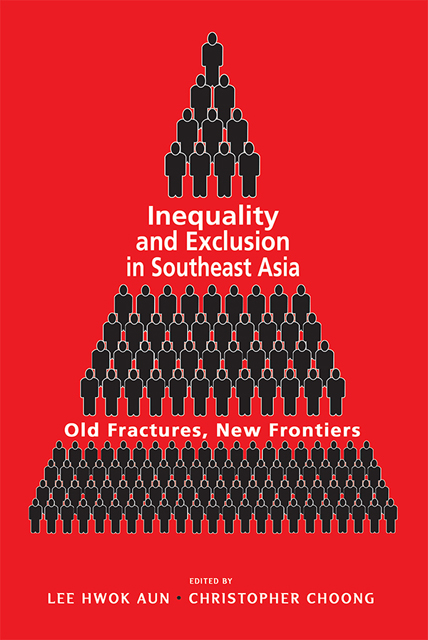Book contents
- Frontmatter
- Contents
- List of Tables
- List of Figures
- Acknowledgements
- About the Contributors
- 1 Introduction: Inequality and Exclusion in Southeast Asia
- 2 Cambodia’s Experiences in Addressing Inequality
- 3 Inequality and Exclusion in Post-Soeharto Indonesia
- 4 Inequality and Exclusion in Malaysia: Macro Trends, Labour Market Dynamics and Gender Dimensions
- 5 Inequality in Myanmar: Structural Change, Policy Outcomes and Gender Dimensions
- 6 Structural Inequality in the Philippines: Oligarchy, Economic Transformation and Current Challenges to Development
- 7 Inequality and the Social Compact in Singapore: Macro Trends vs Lived Inequalities
- 8 Inequality in Thailand: Income, Socio-economic and Wealth Dimensions
- 9 Trends and Drivers of Inequality in Vietnam
- 10 Conclusion: Old Fractures and New Frontiers
- Index
5 - Inequality in Myanmar: Structural Change, Policy Outcomes and Gender Dimensions
Published online by Cambridge University Press: 01 September 2023
- Frontmatter
- Contents
- List of Tables
- List of Figures
- Acknowledgements
- About the Contributors
- 1 Introduction: Inequality and Exclusion in Southeast Asia
- 2 Cambodia’s Experiences in Addressing Inequality
- 3 Inequality and Exclusion in Post-Soeharto Indonesia
- 4 Inequality and Exclusion in Malaysia: Macro Trends, Labour Market Dynamics and Gender Dimensions
- 5 Inequality in Myanmar: Structural Change, Policy Outcomes and Gender Dimensions
- 6 Structural Inequality in the Philippines: Oligarchy, Economic Transformation and Current Challenges to Development
- 7 Inequality and the Social Compact in Singapore: Macro Trends vs Lived Inequalities
- 8 Inequality in Thailand: Income, Socio-economic and Wealth Dimensions
- 9 Trends and Drivers of Inequality in Vietnam
- 10 Conclusion: Old Fractures and New Frontiers
- Index
Summary
INTRODUCTION
Over the past decade, Myanmar has been undertaking political and economic reforms to reintegrate itself to regional and international economic communities. After years of self-isolation and international sanctions, President U Thein Sein, upon his appointment as the head of state, in his inaugural address on 31 March 2011 openly acknowledged the country’s dire situation regarding poverty and unemployment, and initiated an eight-point comprehensive plan for poverty reduction and rural development. U Thein Sein’s government introduced and implemented the Framework of Social and Economic Reforms to initiate short-term liberalization and remedy economic isolation of the past while the succeeding government under State Counsellor Daw Aung San Suu Kyi adopted the longer-term Myanmar Sustainable Development Plan. Various efforts at economic and political liberalization since 2011 have boosted foreign investment and private sector involvement in the country, further integrating Myanmar’s economy to the ASEAN Economic Community and global markets. These reforms broadly transformed the socialist-oriented state-led economy into a vibrant market economy and generated among the fastest economic growth in the region.
Income inequality is relatively low in Myanmar. Income surveys have been scarce, but the available data generate estimates of relatively lower Gini coefficients than most of its Southeast Asian neighbours. This is not surprising, given its economic structure characterized by agricultural employment and labour-intensive industry; low-income countries around the world similarly tend to register low levels of inequality. In accordance with its developmental needs, Myanmar has focused on poverty and significantly alleviated its incidence, although lack of basic income remains a major challenge. Drawing on multidimensional indicators, we observe substantial inequalities, specifically in health and electrification and in the regional dimension, where disparity between Yangon and other regions persists. Educational attainment and labour participation also impact on inequality, hence we also investigate Myanmar’s developments in these areas, where the gender implications are more pronounced. The country’s efforts to redress gender imbalance in socio-economic development, from education to employment, have achieved significant progress, reflected in the boost to Myanmar’s human development indicators when modified to take into account gender inequality, and in the rapidly growing textiles, clothing and footwear manufacturing sectors that predominantly employ young women. Nonetheless, much remains to be done in promoting gender parity.
- Type
- Chapter
- Information
- Inequality and Exclusion in Southeast AsiaOld Fractures, New Frontiers, pp. 133 - 168Publisher: ISEAS–Yusof Ishak InstituteFirst published in: 2023



